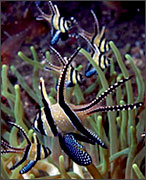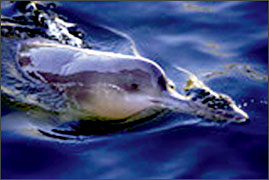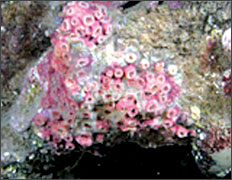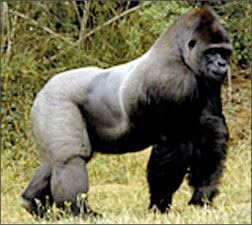The Global Red List of threatened species finds only one species out
of the woods
by Sajitha Prematunge
 |
 |
| Banggai
Cardinalfish |
Ruppell’s Griffon |
What does the Saber-Toothed Tiger, Mammoth, Woolly Stalked Begonia,
Dodo, and Silver trout have in common? They are all extinct. Extinction
means forever and humans are mostly to blame.
The total number of species on the planet is unknown; estimates vary
between 10 - 100 million. Only 1.7 - 1.8 million species are known
today. But this keeps dwindling.
While Habitat destruction and degradation are the major threats to
wildlife, other man induced threats include introduction of invasive
species, unsustainable agriculture, poaching and pollution. Natural
threat to wild species such as disease and climate change have
intensified the circumstances.
2007 IUCN Red List of Threatened Species launched on September 12,
2007, shows that apes, corals, vultures and dolphins are all in danger
of going extinct.

Yangtze River Dolphin or Baiji |

Wellington’s Solitary Coral |
The Red List of Threatened Species, compiled and launched every four
years is a joint effort by IUCN The world Conservation Union, its
Species Survival Commission, its Red List partners BirdLife
International, Conservation International's Center for Applied
Biodiversity Science, NatureServe and the Zoological Society of London.
It's a searchable online database containing the global status and
supporting information on more than 41,000 species.
More information on species included in the 2007 IUCN Red List can be
obtained by visiting the site http://www.iucn.org/themes/ssc/redlist2007/index_redlist2007.htm
launched last week.
Its primary goal is to identify and document the species most in need
of conservation and provide an index of their state of biodiversity. The
Red list classifies species according to their risk of extinction, as
Extinct, Extinct in the Wild, Critically endangered, Endangered,
Vulnerable, Lower Risk/conservation dependent, Near Threatened, Data
Deficient, and Least Concern.

Western Low land Gorilla |
Julia Marton-Lefevre Director General of IUCN the World Conservation
Union has said in their press release for the 2007 Red List "This year's
IUCN Red List shows that the invaluable efforts made so far to protect
species are not enough.
The rate of biodiversity loss is increasing and we need to act now to
significantly reduce it and stave off this global extinction crisis.
This can be done, but only with a concerted effort by all levels of
society." 41,415 species are included in the 2007 Red List and among
them 16,306 are threatened as opposed to 16,118 last year.
The number of extinct species has reached a staggering 785. More over
65 species are only found in captivity or cultivation. One in four
mammals, one in eight birds, one third of all amphibians and 70 per cent
of the world's assessed plants on the 2007 IUCN Red List are in
jeopardy.
The number of threatened species included in the Red List for this
year has increased irrelevant of their taxonomic groups. The habitat of
most threatened birds, mammals and amphibians is the tropical broadleaf
forests, which are believed to harbour the majority of the Earth's
terrestrial and freshwater species.
In fact it turns out that the majority of extinctions since 1500 AD
were recorded from islands but for the past 20 years the extinctions
recorded from the continents have caught up with that of the islands.
Of the countries assessed, Australia, Brazil, China and Mexico hold
particularly large numbers of threatened species. Although estimates
vary, the current extinction rates are at least 100-1,000 times higher
than natural background rates, which signal that man is responsible for
the extraordinary rate at which biodiversity is declining and that he
should take immediate action.
Jean-Christophe Vie Deputy Head of IUCN's Species Programme has said
"From previous experience, we know that conservation can work, but
unfortunately this year we are documenting an improvement for only one
species.
This is really worrying in light of government commitments around the
world, such as the 2010 target to slow down the rate of biodiversity
loss. Clearly, this shows that much more needs to be done to support the
work of thousands of enthusiastic people working everyday throughout the
world to preserve the diversity of life on this planet."
Conservation in recent years have prevented the total extinction of
some species, but unfortunately the findings of the red list show that
only one species have made a come back from the brink of extinction.
The Mauritius Echo Parakeet, which was one of the world's rarest
parrots 15 years ago, has moved from critically endangered to
endangered. Captive breeding and release programmes along with close
monitoring of nesting sites and supplementary feeding has helped to make
the conservation efforts a success.
Holly Dublin, Chair of IUCN's Species Survival Commission, said
"Conservation networks dedicated to fighting the extinction crisis, such
as the Species Survival Commission, are working effectively. But much
more help and support is needed as environmentalists cannot do it alone.
The challenge of the extinction crisis also requires attention and
action from the general public, the private sector, governments and
policy makers to ensure that global biodiversity remains intact for
generations to come."
The 2007 Red list highlights that some species of great apes, corals,
Vultures, North American reptiles, Plant species and Banggai
Cardinalfish runs a risk of going extinct and Yangtze River Dolphin may
already be so. The main subspecies of the Western Gorilla, the Western
Low land Gorilla has been devastated by the commercial bush meat trade
and the Ebola virus.
During the past 20 to 25 years over 60 per cent of its population has
declined and one third of their population found in protected areas have
been killed by the Ebola virus. Due to logging and forest clearance for
palm oil plantations, the existence of the Sumatran Orangutan in the
critically endangered category and the Bornean Orangutan in the
endangered category, are threatened.
This year marks the first appearance of corals in the IUCN Red List.
Although it may sound like a cliche the main threats to species like the
Wellington's Solitary Coral listed as critically endangered or even
possibly extinct is considered to be El Nino and climate change.
Seventy four seaweeds have been added to the IUCN Red List from the
Galapagos Islands with six highlighted as possibly extinct. Other than
El Nino and climate change one of the main threats to these species,
believe it or not, seems to be over fishing.
Over fishing of predator fish results in the surplus of herbivores,
consequently over grazing threatens these algae.
The search for individuals of Yangtze River Dolphin or Baiji has
turned up with nothing, placing it in the possibly extinct category.
Dams, irrigation projects, sand mining and artificial embankments have
all encroached on the Gharial - India and Nepal's crocodiles habitat,
reducing its domain to 2 per cent of its former range, moving it from
endangered to critically endangered.
Vultures of Africa and Asia have showed a decline. Five species of
vulture have moved up the endangered ladder, the Asian Red-headed
Vulture and the Egyptian Vulture, from Africa the White-headed Vulture,
White-backed Vulture and Ruppell's Griffon.
In addition to threats like lack of food, with a reduction in wild
grazing mammals, habitat loss and collision with power lines they have
also been poisoned by carcasses deliberately poisoned with insecticide
intended to kill livestock predators like hyenas.
Ninety Mexican and North American reptiles are threatened with
extinction.
Two Mexican freshwater turtles, the Cuatro Cienegas Slider and the
Ornate Slider are listed as endangered and vulnerable respectively,
threatened due to habitat loss. Mexico's Santa Catalina Island
Rattlesnake has also been added to the list as Critically Endangered.
There are now 12,043 plants on the List. The Woolly-stalked Begonia
is the only species to have been declared extinct this year. Extensive
searches in Malaysian forests have failed to come up with any specimens
in the last 100 years.
Another rookie for the Red is the Wild Apricot from central Asia
classified as Endangered and the major causes are loss of habitat to
tourism and exploitation of the species for wood, food and as a material
for energy sources. Over fishing and aquarium trade has endangered many
species of fish globally.
The Banggai Cardinalfish highly prized as an aquarium species has
entered the list for the first time. Approximately 900,000 of Banggai
Cardinalfish are extracted every year from Banggai Archipelago, Sulawesi,
Indonesia.
Jane Smart, Head of IUCN's Species Programme has said "Our lives are
inextricably linked with biodiversity and ultimately its protection is
essential for our very survival. As the world begins to respond to the
current crisis of biodiversity loss, the information from the IUCN Red
List is needed to design and implement effective conservation strategies
for the benefit of people and nature."
It's clear from the 2007 Red List that species loss is still on the
rise in spite of all the conservation efforts. Loss of biodiversity has
a huge impact on humans all over the world not only in terms of the loss
of genetic information but also in terms of vital provisions as food and
pure water.
Loss of biodiversity will result in the impingement on essential
ecological services as food and water which helps to maintain human
wellbeing. Remember Mammoths and Sabertooths are no longer, so are the
newly added extinct species to the Red list; let's not add any more to
it.
[email protected] |
